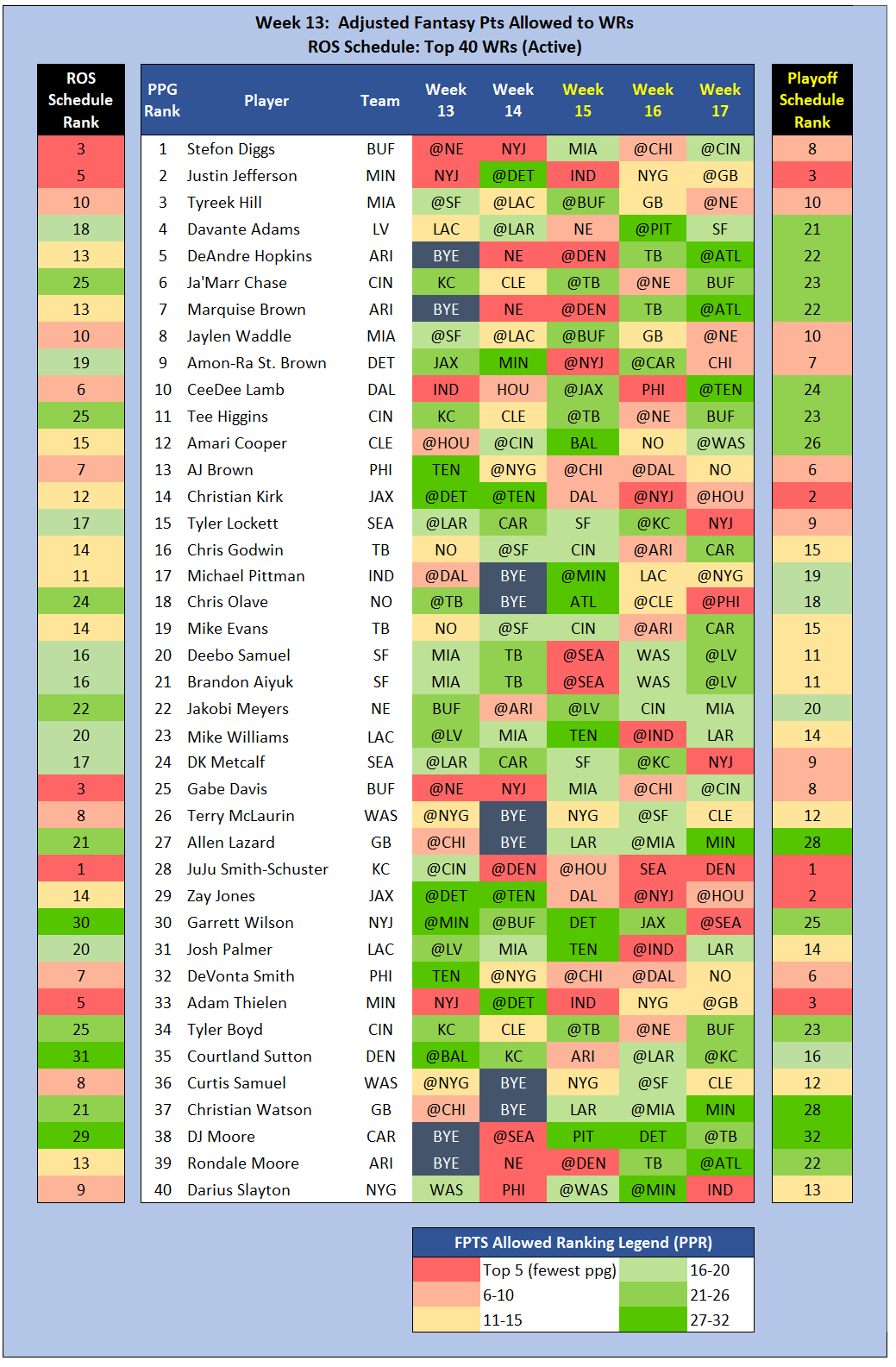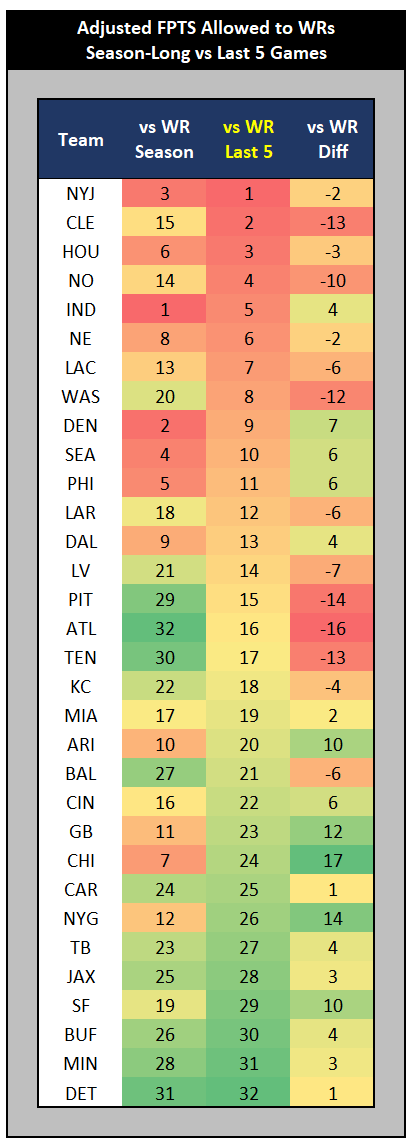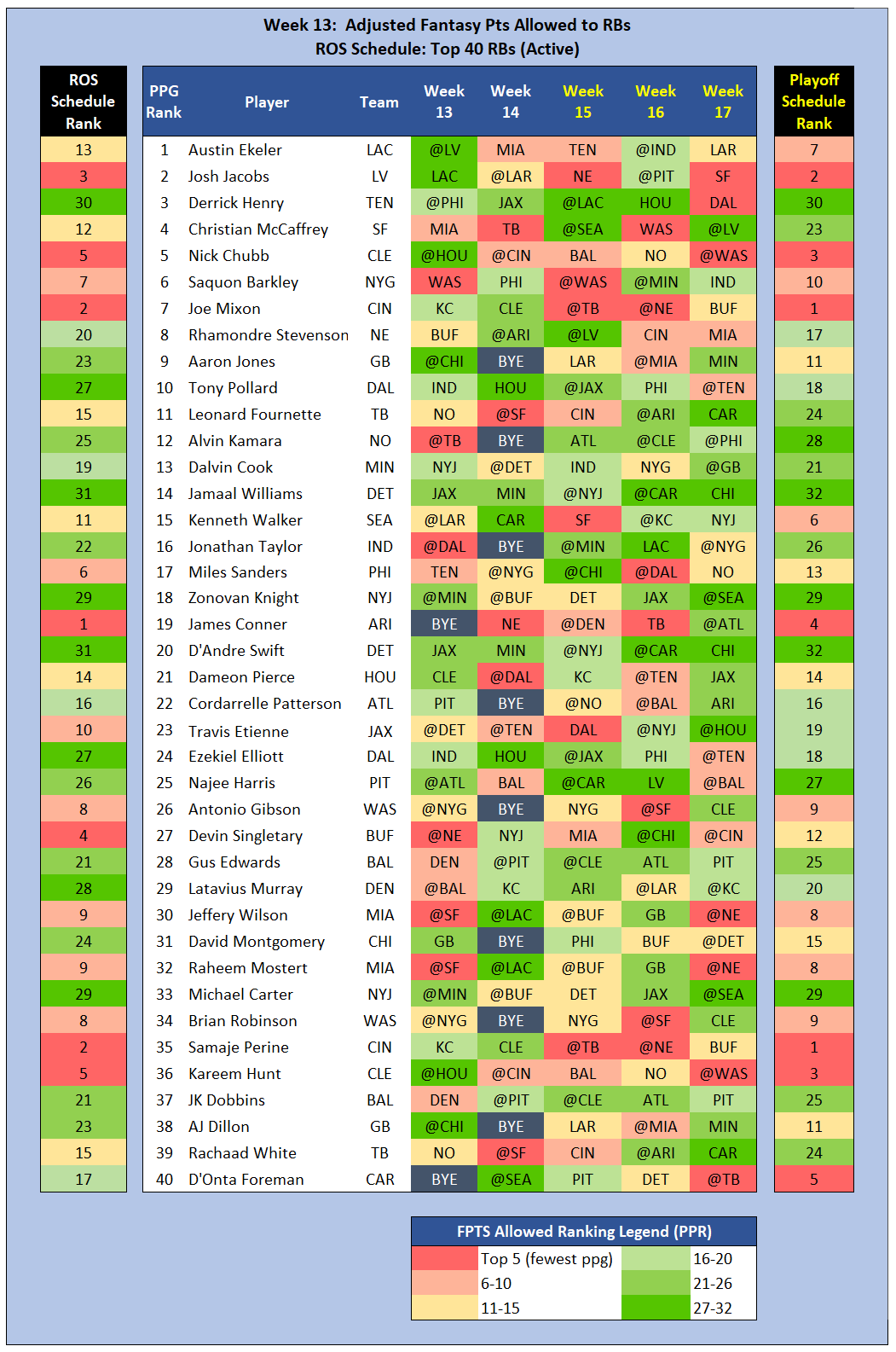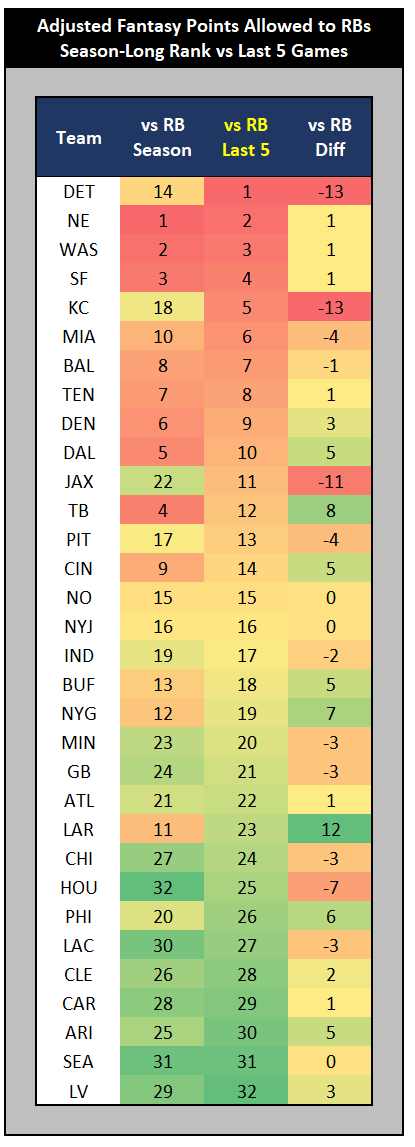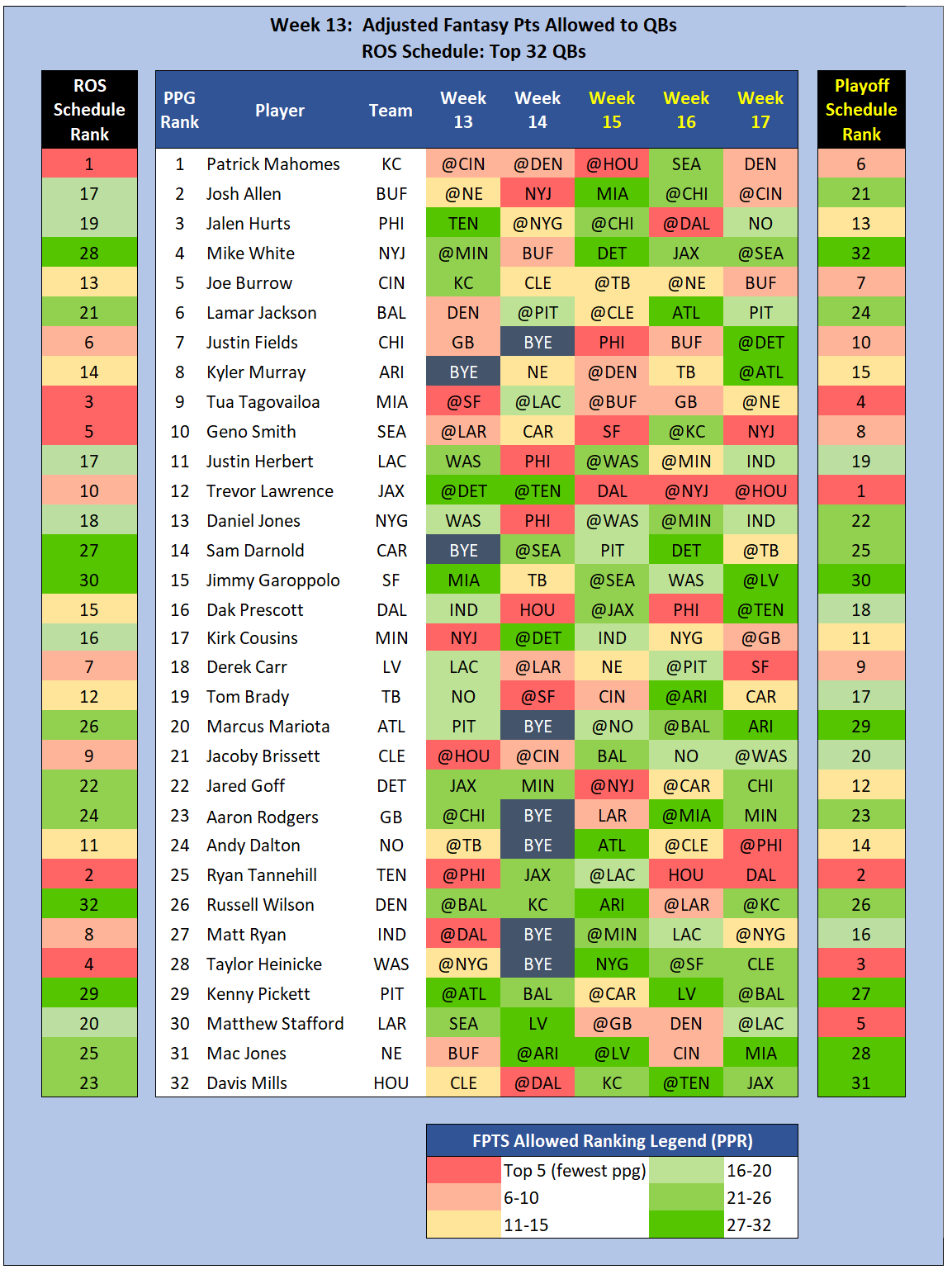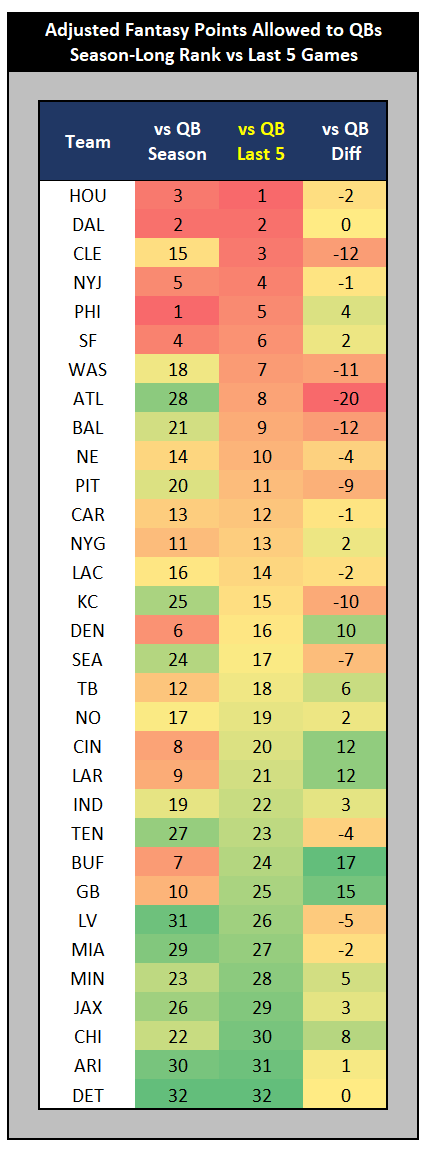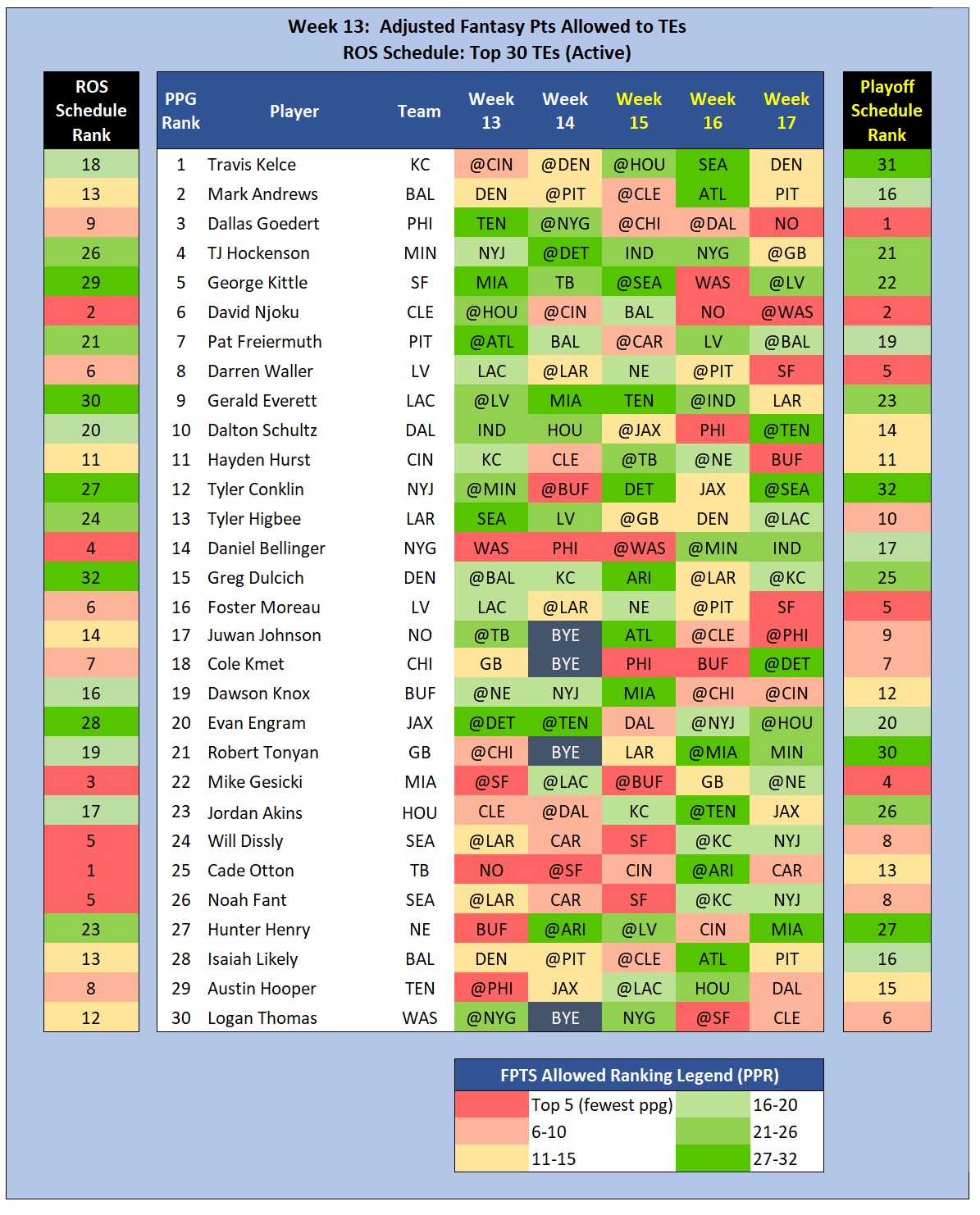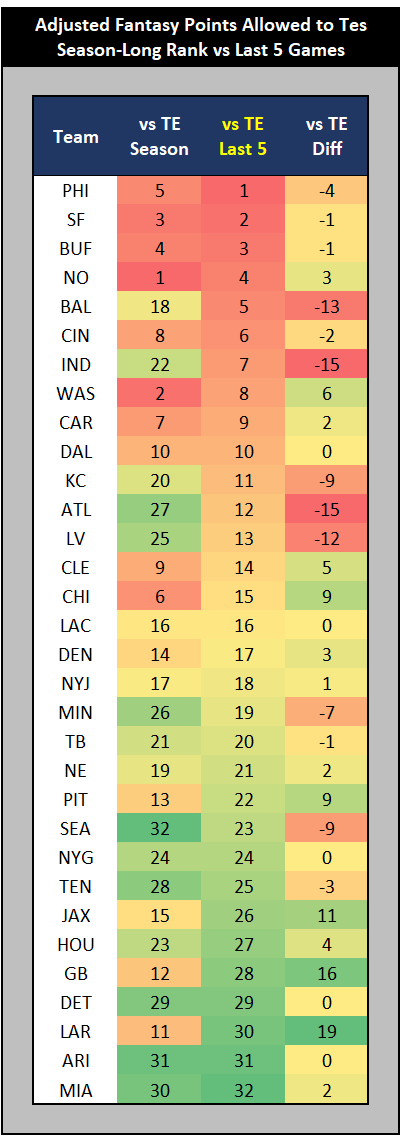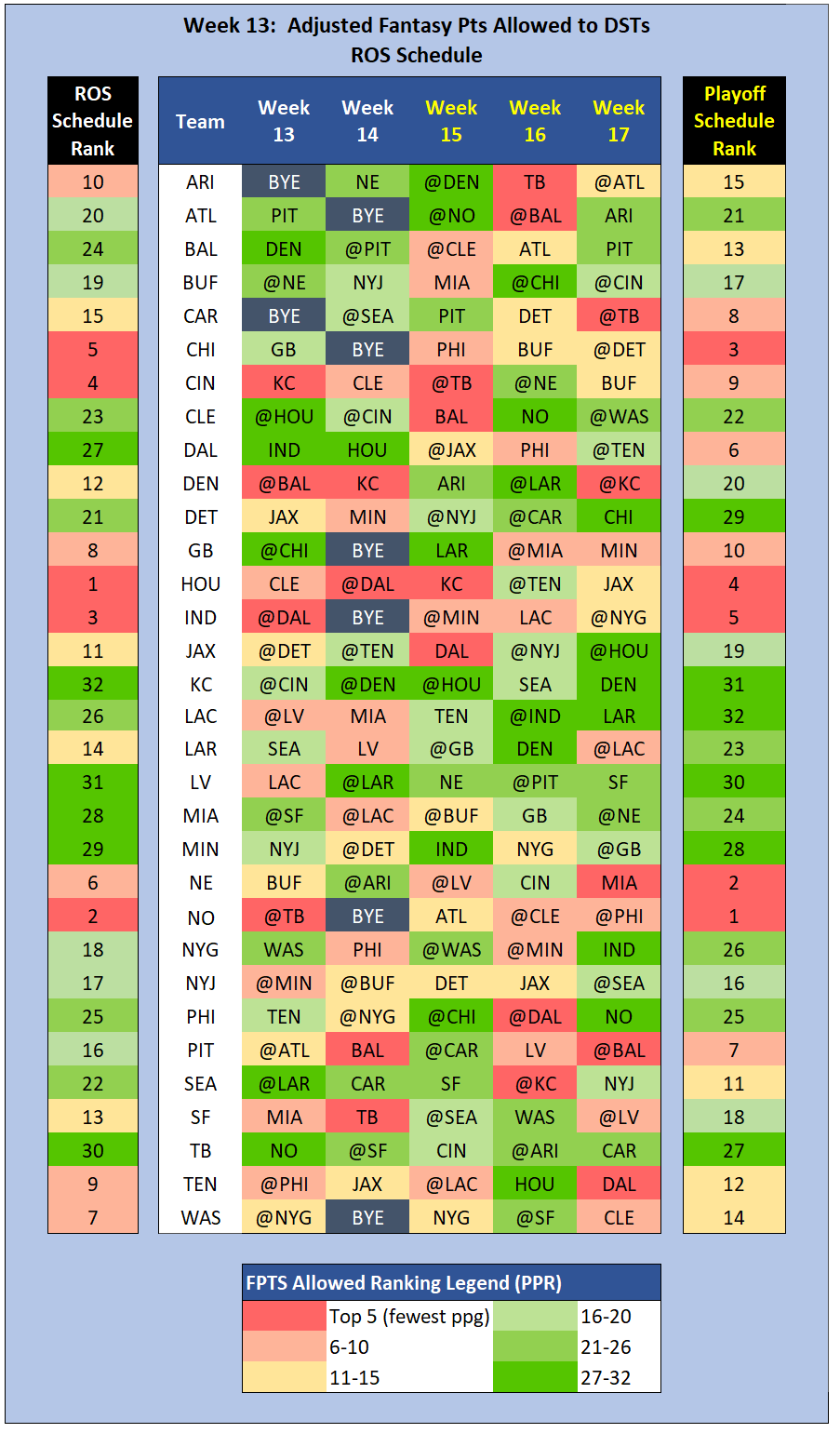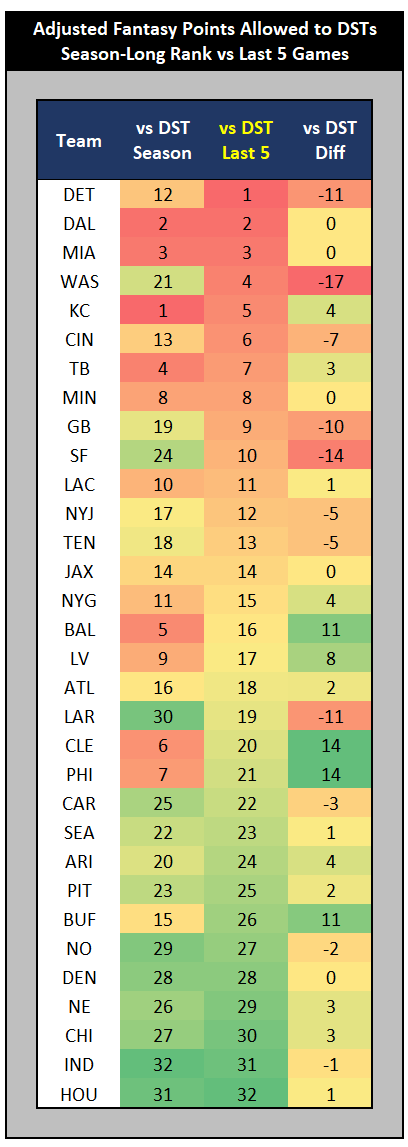Another week of NFL football, another pile of data to sift through looking for clues. Clues as to what leads to certain results and clues for speculating what might be coming next. They say, “looks can be deceiving.” The same can be said for surface-level statistics in fantasy football. In this weekly article series, I will be looking beneath the statistical surface, beyond the standard box score, using the premium statistics provided by FantasyData, including advanced and efficiency metrics across the fantasy skill positions, to search for puzzle pieces that fit together.
Fantasy Football Strength of Schedule
I have spent the last month focusing on the concept of Expected Points among the fantasy football skill positions (not including TE) to see who has been over and underperforming and why. Within that discussion, I included glimpses of fantasy strength of schedule (SOS) to add context for some of the players whose actual fantasy points scored deviated significantly from expectations. I plan to revisit Expected Points and FPOE in the offseason, but right now, it’s fantasy football crunch time. This article will cover the fantasy strength of schedule across the skill position groups (including DST), based on the opponent-adjusted fantasy points allowed data I have been compiling all season.
Generally speaking, my method for adjustment from raw fantasy points allowed to opponent-adjusted fantasy points allowed involves two pieces of data:
- Points allowed to a position compared to the league average points allowed to that position.
- Points allowed to a position compared to that opponent’s per game average.
This helps add quantitative context to the raw fantasy points allowed and is important to factor in when forecasting fantasy strength of schedule. If Team 1 plays against Travis Kelce five games in a row, their raw fantasy points allowed to the TE position would be high, and likely higher than a Team 2 that plays against the Panthers five games in a row. However, that does not automatically mean Team 1 is a more fantasy-friendly matchup. Let’s say Team 1 holds Kelce close to the league average for TE points per game (PPG) and therefore under Kelce’s per game average, and Team 2, while giving up fewer total points, allows Ian Thomas to score well above his season PPG average. In this hypothetical example, that context is baked into Team 1 and Team 2’s overall rank in points allowed to TEs. Indirectly, this mirrors the discussions on Expected Points and FPOE, as you can factor in what teams are giving up compared to what would be expected. But in this case, the expectations are not derived from the context of individual player opportunities, but rather, and more simply, what that position group for that team has already been doing.
As with any method of adjustment like this, it is not a perfect solution. It is still oversimplifying what is happening to a degree. That is the main reason for this article. I will add further context to certain fantasy points allowed rankings and show you another data set I find useful: Recent trends.
I will be showing both season-long and “last five games” adjusted fantasy points allowed data, as only relying on season-long data can be misleading when looking at a position group’s remaining schedule of fantasy opponents. This also decreases the impact of “spike weeks” earlier in the season. But, much like with season-long data, you cannot only look at recent trends data either. Using TEs again, a team may have played five straight teams with weak TEs, and even the opponent adjustment in that scenario can get lost in translation. Let’s say Team 2 from the above example holds Ian Thomas below his PPG average in those five games. Team 2’s “last five games” points allowed rank will make them seem like a brutal matchup for TEs. And that might be true. But in this scenario, it is important to expand to see how Team 2 faired versus better TEs outside of that five-game set.
Starting with the WR position, the following will be included:
- Current Top 40 players in PPR PPG. I have taken a few liberties with the fantasy position leaderboards used in this article. My typical “minimum games” threshold for inclusion is not relevant because we want to see this data for players who are currently active. It does us no good to look at Breece Hall’s fantasy strength of schedule, but we do want to see it for Zonovan Knight, even with only one game played.
- Remaining opponents and where each individual opponent ranks in season-long adjusted fantasy points allowed. I used similar conditional formatting for this, where red equals a tough matchup and green equals a fantasy-friendly matchup.
- Rest of Season (ROS) fantasy Strength of Schedule (SOS) (Average rank across remaining opponents (Week 13-17))
- Fantasy Playoffs fantasy SOS (Average rank during Fantasy Playoffs (Week 15-17))
- Season-long versus Last 5 Games rank in adjusted fantasy points allowed
To be clear, I am not presenting this data as any form of start/sit advice. For instance, Nick Chubb has a brutal Fantasy Playoff schedule. Michael Carter’s is the fourth-easiest. I am not implying you should sit Nick Chubb or start Carter over a higher PPG-ranked player with a tougher schedule. This is to show you what is ahead for your fantasy players so you can plan accordingly, which can take on many forms. This data helps if you are potentially streaming at QB, TE, and/or DST to get ahead of your league mates in making some moves. We are at a time of year when rostering two QBs (in one-QB leagues) or multiple DSTs can be a good strategy as the remaining matchups are crucial. If your league’s trade deadline has not passed (or doesn’t have one), this can be useful in choosing who and when to try and buy or sell. But please do not start Michael Carter over Nich Chubb.
NOTE: The Week 13 Thursday Night Football (TNF) between the Patriots and Bills is not factored into this data. You will still see the Week 13 matchup for each Patriots and Bills player included here.
Fantasy Strength of Schedule: Top 40 WRs
A good starting place here is looking for players with higher (greener) or lower (redder) numbers in both the ROS and Fantasy Playoffs columns.
According to this season-long data, WRs with fantastic remaining schedules (>20 rank for both ROS and Playoffs, meaning ~bottom 10 in FPTS allowed to WRs) include Ja’Marr Chase, Tee Higgins, Allen Lazard, Garrett Wilson, Tyler Boyd, Christian Watson, and DJ Moore. Obviously, you can just show this data for each team’s remaining schedule rather than the individual players. This is something I post to Twitter weekly and what you will see on most sites that provide fantasy SOS. But like I said, it’s crunch time, and I want to cut out one of the steps for you as the consumer. Here you can go straight to the player on your team and see what their schedule looks like. If there are players you want to know about not on this list, as most of the teams are represented.
WRs with great Fantasy Playoff schedules (>20 rank, not already listed above) include Davante Adams, DeAndre Hopkins, Marquise Brown, CeeDee Lamb, Amari Cooper, and Rondale Moore.
Part of the usefulness of this data also comes into play if your league has no trade deadline. Across all of the position groups, if you are locked into a playoff spot you can look to acquire players who have a favorable Fantasy Playoffs schedule, even if their Week 13 and 14 opponents are tough or they still have a bye. An example would be Christian Watson. If your league mate with Watson is battling it out for the playoffs, they may be enticed to acquire a player who is playing in Week 14 for Watson who is on bye, and Watson has the fifth-easiest Fantasy Playoff schedule according to this data.
On the flip side, WRs with tough remaining schedules (<10 rank for both ROS and Playoffs, meaning Top 15 in fewest fantasy points allowed) include Stefon Diggs, Justin Jefferson, AJ Brown, Gabe Davis, JuJu Smith-Schuster, DeVonta Smith, and Adam Thielen.
WRs with brutal Fantasy Playoff schedules (Top 10 rank in fewest FPTS allowed, not already listed above) include Tyreek Hill, Jaylen Waddle, Amon-Ra St. Brown, Christian Kirk, Tyler Lockett, DK Metcalf, and Zay Jones. The Jaguars and Seahawks WRs are interesting because while they have tough Fantasy Playoff schedules, both teams have favorable matchups in Week 13 and 14. Without a trade deadline, you could test the waters and try to catch your league mates napping, and try to sell for players with more favorable Fantasy Playoff schedules (especially if these WRs have any big games against these weaker opponents in the next two weeks).
Now for some additional context. Here is the comparison between Season-Long and Last 5 games in adjusted FPTS allowed to WRs, sorted from toughest to easiest matchup over the Last 5:
The key to this chart is looking at the third column, which is the difference in rank between Season-Long and Last 5 Games. The closer to zero, the more consistent the team has been at their given rank. Greater differences (green) indicate teams who have been more fantasy-friendly as of late, and negative differences (red) indicate teams who have been much tougher versus WRs over their last five games.
Teams who have jumped at least 10 spots in rank (negative difference, been tougher against WRs) include the Browns, Saints, Commanders, Steelers, Falcons, and Titans. The latter three have been torched by WRs looking at season-long data, so the recent trend jump brings them more to the middle of the pack. It is the Browns, Saints, and Commanders that stand out here as all three have been in the Top 10 over their last five games. The Commanders have been brutal versus RBs all season (as you’ll see) but more fantasy-friendly to WRs. That seems to have changed according to the recent trend. So are they now a bad WR matchup? My answer is kind of. I think they are better than their season-long number indicates, but three of their last five games were against the Colts, Texans, and Falcons, with the highest-ranked WR in PPR PPG they’ve faced being Michael Pittman Jr. (WR32).
The biggest fallers over the last five games (positive difference of 10 or more spots) include the Cardinals, Packers, Bears, Giants, and 49ers. Here are these teams’ last five opponents:
- Cardinals: Vikings, Seahawks, Rams, 49ers, and Chargers.
- Packers: Bills, Lions, Cowboys, Titans, and Eagles
- Bears: Cowboys, Dolphins, Lions, Falcons, and Jets
- Giants: Jaguars, Seahawks, Texans, Lions, and Cowboys
- 49ers: Chiefs, Rams, Chargers, Cardinals, and Saints
So you can see, plenty of top-level WRs but also a mix of more mediocre WR groups, which means the more accurate rank for these teams is likely somewhere in between their season-long and recent trends.
Fantasy Strength of Schedule: Top 40 RBs
I will be moving through the rest of the position groups in less detail. With only two weeks left in the fantasy regular season, I want to cover each position group and avoid breaking this up across multiple articles. The further discussions about reasoning and trade strategy discussed in the WR section apply across the position groups so I will not repeat that moving forward.
According to this season-long data, RBs with favorable remaining schedules (>20 rank for both ROS and Playoffs) include Derrick Henry, Alvin Kamara, Jamaal Williams, Jonathan Taylor, Zonovan Knight, D’Andre Swift, Najee Harris (and therefore Jaylen Warren), Gus Edwards, Latavius Murray (playoff rank right at 20th), Michael Carter, and JK Dobbins.
RBs with great Fantasy Playoff schedules (>20 rank, not already listed above) include Christian McCaffrey, Leonard Fournette, and Dalvin Cook. If you lower the threshold to a >15 Fantasy Playoffs rank you can add Rhamondre Stevenson, Tony Pollard, Cordarrelle Patterson, Travis Etienne, and Ezekiel Elliott. Regarding McCaffrey, his Fantasy Playoff is ranked 32nd (easiest) when looking at adjusted fantasy points allowed to RBs via receiving output only (PFR).
RBs with tough remaining schedules (<10 rank for both ROS and Playoffs) include Josh Jacobs, Nick Chubb, Saquon Barkley, Joe Mixon, James Conner, Antonio Gibson, Jeffrey Wilson, Raheem Mostert, Brian Robinson, Samaje Perine, and Kareem Hunt.
The only player with a Top 10 toughest Fantasy Playoff schedule who does not also have a Top 10 ROS schedule is D’Onte Foreman.
Here is the comparison between Season-Long and Last 5 games in adjusted FPTS allowed to RBs, sorted from toughest to easiest matchup over the Last 5:
There is not as much movement in this RB chart compared to the WR chart above. Twenty-three of the 32 NFL teams are within five spots of their season-long rank versus RBs. Teams who have jumped at least 10 spots in rank (negative rank difference; been tougher against RBs) include the Lions, Chiefs, and Jaguars. This is important because, at least for me, these are three teams who at first glance I would be tempted to assume are great RB matchups. Some of that is recency bias of previous seasons (and earlier this season). Here are the last five opponents for these teams:
- Lions: Dolphins, Packers, Bears, Giants, and Bills
- Chiefs: 49ers, Titans, Jaguars, Chargers, and Rams
- Jaguars: Giants, Broncos, Raiders, Chiefs, and Ravens
So once again, a mixture of strong and weaker RB opponents for each team, but I do think this factors into a few of the players and season-long rankings listed above. But the rabbit hole can seem endless. Saquon Barkley scored 17.5 PPR points versus the Jaguars in Week 7 (four catches, 135 total yards, zero TDs), which is slightly above Barkley’s current PPG average. And at that time, the Jaguars were ranked 24th versus fantasy RBs, so that seems like a positive. But Daniel Jones also ran for over 100 yards and a TD in that game, so that particular game data point within the “Last 5 Games” rank does not tell the whole story. Still, the difference for these teams is notable. According to season-long adjusted FPTS allowed, the Jets have the 29th-ranked (fourth-easiest) Fantasy Playoff schedule for RBs. However, two of their three opponents are the Lions and Jaguars, so that schedule is likely not quite as easy as it looks.
There is only one team who has fallen more than 10 spots (positive difference of at least 10), and that is the Rams. The Rams’ last five opponents include:
- Rams: 49ers, Buccaneers, Cardinals, Saints, and Chiefs.
The highest-ranked RB in PPR PPG among those opponents is Leonard Fournette at RB19 (McCaffrey was not with the 49ers when they last played the Rams). The Rams have turned into one of the biggest train wrecks of 2022, and likely the worst post-Super Bowl-winning season ever. This Last 5 Game trend versus fantasy RBs looks to be more of the new normal for the Rams.
Fantasy Strength of Schedule: Top 32 QBs
For the QBs, I have manipulated the leaderboard in an attempt to present the current starting QBs for all 32 NFL teams. Mike White is listed at QB4 after only one game not because he belongs that high, but because he needs to be on this list as the current starter for the Jets. Non-starters like Jameis Winston and Carson Wentz have been removed. The exceptions to this are Jacoby Brissett, Davis Mills, and Matthew Stafford. For those players, you can substitute the current starter.
According to this season-long data, QBs with favorable remaining schedules (>20 rank for both ROS and Playoffs) include Mike White, Lamar Jackson, Sam Darnold, Jimmy Garoppolo, Marcus Mariota, Aaron Rodgers, Russell Wilson, Kenny Pickett, Mac Jones, and Davis Mills/Kyle Allen.
QBs with tough remaining schedules (Top 10 toughest schedule for both ROS and Playoffs) include Patrick Mahomes, Justin Fields, Tua Tagovailoa, Geno Smith, Trevor Lawrence, Derek Carr, Ryan Tannehill, and Taylor Heinicke. Regarding some of the trading strategies discussed earlier in the article, Trevor Lawerence jumps out at me from this group. Lawerence has played well lately and faces two bottom 10 opponents in Week 13 (Lions) and Week 14 (Titans). He then has the toughest Fantasy Playoff Schedule according to this data. If you are relying on Lawerence, you might attempt a sell for another QB after the next two games (although that is not likely to be successful), or look to stream in the playoffs. The QBs I would consider who have good Fantasy Playoff schedules and are at least potentially a streaming option include Mike White (easiest schedule), Daniel Jones (eleventh-easiest schedule), Jimmy Garoppolo (third-easiest schedule), and Kenny Pickett (sixth-easiest schedule).
Here is the comparison between Season-Long and Last 5 games in adjusted FPTS allowed to RBs, sorted from toughest to easiest matchup over the Last 5:
Teams who have jumped at least 10 spots in rank (negative difference, been tougher against QBs) include the Browns, Commanders, Falcons, Ravens, and Chiefs.
The team that jumps out here is the Falcons. This is another team (like the Lions and Jaguars with RBs) that my mind automatically considers a good matchup, really for any fantasy skill position. So the Falcons need a closer look. Here are Atlanta’s last five opponents, and where the QBs for those teams rank in fantasy PPG (according to FantasyData):
- Panthers (PJ Walker started this game)
- Chargers (QB11)
- Panthers (PJ Walker again)
- Bears (QB7)
- Commanders (QB31)
Justin Herbert was not playing well against anyone at that point in the season. Holding Justin Fields to his season-long PPG average (20.6) in the Week 11 game was better than expected, but based on these opponents the Falcons are closer to their season-long rank versus QBs than what they have done over the last five games.
The biggest fallers over the last five games (positive difference of 10 or more spots) include the Broncos, Bengals, Rams, Bills, and Packers. Here are these teams’ last five opponents, and the fantasy PPG rank of the QBs they have faced:
- Broncos: Jets (QB36), Jaguars (QB12), Titans (QB30), Raiders (QB19), and Panthers (Sam Darnold’s first start).
- Bengals: Falcons (QB21), Browns (QB22), Panthers (QB38), Steelers (QB32), and Titans (QB30).
- Rams: 49ers (QB15), Buccaneers (QB20), Cardinals (QB8), Saints (QB27), and Chiefs (QB1).
- Bills (not including Week 13 TNF): Packers (QB26), Jets (QB36), Vikings (QB17), Browns (QB22), and Lions (QB23).
- Packers: Bills (QB2), Lions (QB23), Cowboys (QB17), Titans (QB30), and Eagles (QB3).
This list is troubling. Only the Packers and Rams have faced a Top 10 fantasy QB over their last five games. I would expect the recent trends for these teams to include a much tougher gauntlet of fantasy QBs than what this shows. All five of these teams are likely closer to this recent trend than their season-long rank versus QBs. This does have an impact on the ROS and Fantasy Playoffs schedules based on season-long data. Patrick Mahomes, not that you would ever bench him, is shown to have the toughest ROS schedule. But that is with two games against the Broncos and one against the Bengals, who are ranked in the Top 10 according to season-long numbers. Based on the recent trend, the Chiefs’ only remaining game against a tough QB defense is in Week 15 at the Texans. The other QB for which this affects the outlook is Tua Tagovailoa. According to season-long rankings, the Dolphins have the fourth-toughest Fantasy Playoff schedule for fantasy QBs. However, that includes games against both the Bills and the Packers, also teams still in the Top 10 according to season-long data.
Fantasy Strength of Schedule: Top 30 TEs
TEs with favorable remaining schedules (>20 rank for both ROS and Playoffs) include TJ Hockenson, George Kittle, Pat Freiermuth (Playoff schedule at 19th), Gerald Everett, Tyler Conklin, Greg Dulcich, Evan Engram, and Hunter Henry.
TEs with great Fantasy Playoff schedules (>20 rank, not already listed above) include Travis Kelce, Robert Tonyan, and Jordan Akins.
TEs with tough remaining schedules (<10 rank for both ROS and Playoffs) include Dallas Goedert, David Njoku, Darren Waller, Foster Moreau, Cole Kmet, Will Dissly, and Noah Fant.
TEs with tough Fantasy Playoff schedules (Top 10 rank not already listed) include Tyler Higbee, Juwan Johnson, and Logan Thomas.
Here is the comparison between Season-Long and Last 5 games in adjusted FPTS allowed to RBs, sorted from toughest to easiest matchup over the Last 5:
Teams who have jumped at least 10 spots in rank (negative difference, been tougher against TEs) include the Ravens, Colts, Falcons, and Raiders.
The biggest fallers over the last five games (positive difference of 10 or more spots) include the Jaguars, Packers, and Rams. This makes sense as these are also three of the teams who have been more fantasy-friendly to QBs over their last five games, and the TEs on those teams have benefitted.
Fantasy Strength of Schedule: NFL DSTs
DSTs with favorable remaining schedules (>20 rank for both ROS and Playoffs) include the Falcons, Browns, Lions, Chiefs, Chargers, Raiders, Dolphins, Vikings, Eagles, and Buccaneers. The teams to pay attention to from this list are the Chiefs, Chargers, and Dolphins because these are also decent NFL defenses (their appeal is not based solely on the matchups). The Eagles and Buccaneers are likely not available based on rostership percentages. The Falcons, Browns, Lions, and Raiders do have some good matchups, but I tend to avoid starting bad NFL defenses only due to a good DST matchup.
DSTs with tough remaining schedules (Top 10 rank for both ROS and Playoffs) include the Bears, Bengals, Packers, Texans, Colts, Patriots, and Saints. Most of these teams are not ideal DSTs regardless of matchup, but the Patriots have been the number one DST for most of the season. I also tend to avoid locking into one DST, even one like the Patriots, regardless of the matchup. If I roster the Patriots’ DST, that is a scenario where I am looking to acquire a DST like the Chiefs, who have favorable matchups during the weeks in which the Patriots do not.
Here is the comparison between Season-Long and Last 5 games in adjusted FPTS allowed to DSTs, sorted from toughest to easiest matchup over the Last 5:
Teams who have jumped at least 10 spots in rank (negative difference, been tougher against DSTs) include the Lions, Commanders, Packers, 49ers, and Rams. Here are the last five opponents for each of these teams:
- Lions: Dolphins, Packers, Bears, and Giants.
- Commanders: Colts, Vikings, Eagles, Texans, and Falcons.
- Packers: Bills, Lions, Cowboys, Titans, and Eagles.
- 49ers: Chiefs, Rams, Chargers, Cardinals, and Saints.
- Rams: 49ers, Buccaneers, Cardinals, Saints, and Chiefs.
To be clear, this is not showing which DSTs have scored more fantasy points recently. These are teams who have been tougher matchups against DSTs than their season-long rank. To oversimplify, these offenses have been putting up more points over the last five games than their season-long numbers. The Lions have been the toughest matchup for opposing DSTs in the last five games. But the Lions’ season-long rank is the 12th toughest, so this trend does not significantly impact the ROS and Fantasy Playoff schedule. The team of note here is the 49ers. The 49ers’ season-long rank is 24th, meaning the ninth-best team to start your DST against. Over their last five, they are the tenth-toughest, which is much closer to reality with the addition of McCaffrey and the way the San Francisco offense has been playing.
The biggest fallers over the last five games (positive difference of 10 or more spots) include the Ravens, Browns, Eagles, and Bills, meaning these teams have been better matchups for your DST as of late. For each of these teams, I believe the recent trend is a mirage. These teams’ season-long ranks (all within the Top 15) are more representative of what to expect ROS.
Thanks for reading! If you have any questions about the data used in this article or about fantasy football in general, feel free to hit me up on Twitter.

